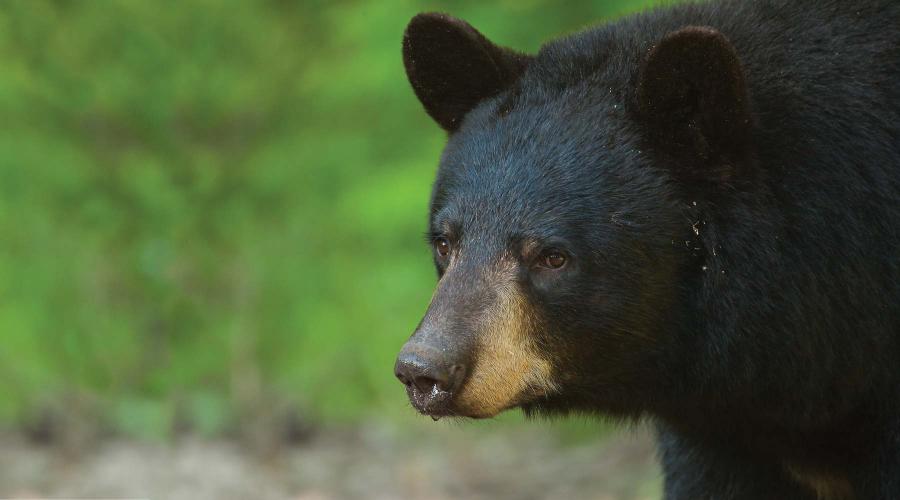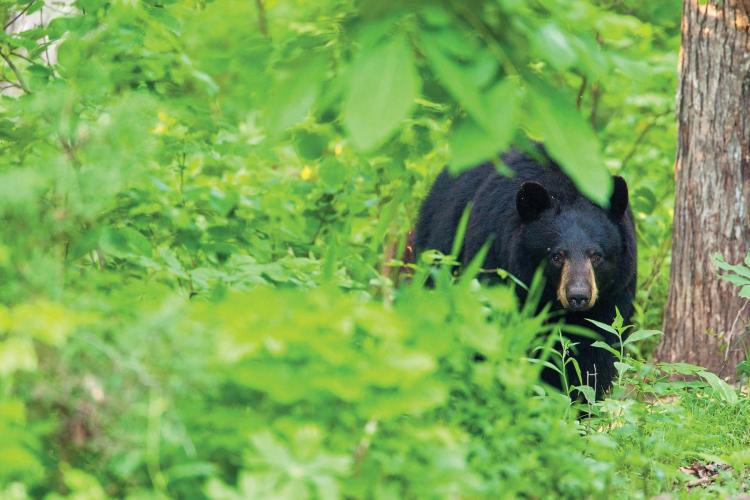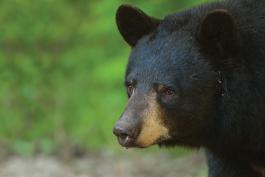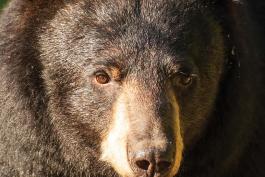If you want to know a sixth grader’s opinion, just ask. I’ve spent a lot of time over the last few years asking sixth graders how they feel about sharing their Missouri forests with bears. As you can imagine, it’s rare for them to have a less than strong opinion about it. Even the ones who are too shy to speak up in front of their classmates will betray their opinion with their expression — eyes widen, mouths start to gape, brows furrow.
Sixth graders, like the rest of us, are just getting used to the idea that we have a bear population in the state of Missouri. And in the first five minutes of a school program, they grapple with what it means to live with bears until I give them a very simple answer: be aware.
The truth is they already know many of the concepts of being bear aware. They may have to think about it for a moment to realize they know it, but it’s there. Maybe it’s in some instinctual recesses of their mind or maybe it’s just plain common sense, but kids know. Simply being aware that seeing a bear is a possibility is half the battle.
Like most Missourians, I’ve grown up never thinking about running into a bear. Whether I was hunting on U.S. Forest Service land south of Birch Tree that borders my parents’ property or camping along the banks of the Jacks Fork River, it was never a thought or a strong possibility until recently.
In some ways, the sixth graders have an advantage over the rest of us. They will grow up in a Missouri where bear sightings and a healthy bear population are just everyday facts. The rest of us will be like the old timers of today who can still remember when seeing a deer was front-page news in certain rural parts of Missouri. Those of us who grew up without bears face the exciting challenge of learning how to coexist with them. Luckily for us, it’s a rewarding challenge.
Bear Aware Biology
Laura Conlee, MDC’s furbearer biologist, knows a thing or two about living with bears. She’s spent the last eight years working directly with bears and, in many cases, the communities around those bears.
“The best way to coexist is to sometimes modify our own behaviors,” said Conlee. “So there may be things that people need to do to be able to coexist with bears.
“For instance, you don’t want to draw bears to your residence, and for a rural resident, that’s very important. These bears are using really big forest blocks, and they may occasionally come across a house, and if they don’t get food there, they’re just going to keep going because there’s plenty of food in the forest for them. But if they get there and trash is readily available or there’s a lot of chicken feed sitting out that they can get at, then they’re going to take advantage of that.”
Conlee explains that one of the most challenging things about keeping bears from becoming a nuisance is their memory.
“Bears can learn something almost instantaneously and remember it. They have a really good memory, and they’re going to come back and revisit it again and again. And bears need to learn something just once. They generally don’t forget it, and if it’s a female, they pass it along to their young.”
So how do we make sure the intelligence of such a smart animal doesn’t cause conflict with residents?
“The key is to learn quicker than the bear,” said Conlee. “So if you notice that a bear has gotten into something, remedy it immediately.”
Conlee also stresses prevention over reaction, and respect over fear.
“Our baseline reaction to bears shouldn’t be fear. Missourians should be proud of the bear population in the state and their success story. They’ve rebounded from nearly nonexistent numbers to a healthy and growing population. We just need to be mindful that our actions have direct impacts on these animals.”
For Conlee, it comes down to learning to live with an animal in the same way that we’ve learned to live with other animals in the state.
A Landowner’s Perspective
Rebecca Isaacs also knows something about what it means to live with bears. She and her family have been doing it for about 15 years.
“We probably started having bears around our house 15 years ago,” said Isaacs. “And then probably about 10 to 12 years ago was when we noticed the population increase.
At that time we had cattle, so we had grain in our barn. We didn’t keep it secured or anything, we just stacked it on pallets. So the bears would come to the grain.”
When asked about the changes she and her family made to coexist with bears, she echoed Conlee and said the changes were relatively simple and easy.
“We had to learn to secure the smell of the grain by keeping it in an enclosed part of the barn,” said Isaacs. “We dispose of our trash promptly. We took down the automatic dog feeder.
“And we haven’t seen a bear at our house in a long time after making those changes.”
These new habits didn’t just help with their bear population. It reduced their raccoon and opossum problems.
The Isaacs family loves to be outdoors and spends a lot of time hiking, horseback riding, and four-wheeling across their Ozarks property. So learning to live with bears at home was only part of the acclimation — they also changed some of their habits in the field.
“In our deer stands, if we leave even a cracker package, they will find it,” said Isaacs. “As we changed our habits of having open food, we had fewer problems. Not just at home, but also in our deer stands. You don’t leave food behind, you don’t leave wrappers, and you don’t leave trash. And even though we weren’t feeding them, they were attracted to that food.”
Isaacs says the changes have been rewarding. She and her family have participated in den studies and trapping activities to help MDC learn more about bear population in the state. They thoroughly enjoy sharing their property with black bears.
“Once we changed things so they’re not on our back porch, it was great. Walking out and seeing one on your porch is a little intimidating. So when we made those changes and we began seeing the bears out on the property, it was cool to be sitting out there or four-wheeling through the property and see a female and her two cubs.”
Bears require respect from us. This respect is rewarded with unforgettable opportunities to view an incredible animal in a landscape where it was once an everyday feature.
Whether you’re a sixth grader, a bear biologist, or a landowner, the general consensus seems to be the same — bears are pretty cool and so is having them in Missouri. So as we all learn together what it means to live with bears, don’t forget to enjoy them. If you have the pleasure of seeing a bear from a safe distance, make sure you savor the moment. It won’t be one you soon forget.
If You Encounter a Bear Up Close
- Never corner a bear — make sure it has an escape route.
- Back away from a bear slowly with your arms raised.
- Speak in a calm, loud voice.
- Do not turn your back to a bear.
- Walk away slowly — DO NOT RUN.
- Bear spray, a form of pepper spray, is a very effective tool if a bear is within 10 yards of you.
Around Home
- Never feed a bear on purpose or accidentally. A bear that has gotten used to getting food from humans may become aggressive and dangerous. When this happens, the bear must be destroyed.
- Don’t leave pet food sitting outside. Feed pets a portion they’ll eat at each meal and remove the empty containers.
- Store garbage, recyclables, and compost inside a secure building or in a bear-proof container until the day of trash pick-up.
- Keep grills and smokers clean and store them inside.
- In bear country, keep bird-feeding areas clean of seed husk piles and hang feeders at least 10 feet high and 4 feet away from any structure to keep bears from accessing/reaching the seed.
Around Camp or in the Field
- Make noise so you don’t surprise a bear — clap, sing, or talk loudly. Travel in a group if possible.
- Pay attention to your surroundings and watch for bear sign, such as tracks or claw or bite marks on trees.
- Keep dogs leashed.
- If you see a bear, leave it alone. Do not approach it. Make sure it has an escape route.
How to Set Up a Bear Aware Campsite
- Choose a place to camp away from animal trails, berry patches, and fresh bear sign (tracks, scat, clawed-up trees).
- Place your tent upwind and at least 100 yards away from cooking and food storage areas.
- Keep a clean camp. Wash and put away pots and utensils after you are done using them. Wipe off picnic tables. Pick up any scraps of food that you drop.
- Change into clean clothes before bed. Store the clothes that you wore while cooking in a bear-proof container along with other smelly items.
- Store smelly items away from your tent and cooking area. Place them inside a vehicle with the windows rolled up, in a bear-proof canister, or hung in a bag from a branch at least 10 feet high and 5 feet away from the trunk.










Also In This Issue


And More...
This Issue's Staff
Art Director - Cliff White
Associate Editor - Bonnie Chasteen
Staff Writer - Heather Feeler
Staff Writer - Kristie Hilgedick
Staff Writer - Joe Jerek
Photographer - Noppadol Paothong
Photographer - David Stonner
Designer - Les Fortenberry
Designer - Marci Porter
Designer - Stephanie Thurber
Circulation - Laura Scheuler






















